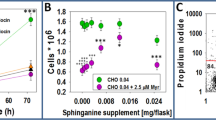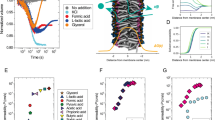Abstract
CELLS growing in a chemically defined, sterol-free medium must synthesise cholesterol or, in the case of L cells, desmosterol1 for membrane formation. Studies by others showed that when cholesterol or desmosterol was added to L-cell cultures the exogenous sterol was utilised and the rate of sterol synthesis was diminished, presumably by a negative feedback mechanism2,3. Our observations4, however, provide new information regarding the structures of sterols that affect sterol synthesis. Exogenous cholesterol and various metabolically related steroids do not inhibit sterol synthesis in mouse liver cell or fibroblast cultures under conditions where derivatives of cholesterol oxygenated in the 7, 20, 22 or 25 positions are highly inhibitory. These inhibitory sterols, at concentrations of 0.02–0.2 µg ml−1 specifically depress the activity of the regulatory enzyme in the sterol synthetic pathway, 3-hydroxy-3-methylgrutaryl-coenzyme A (HMG-CoA) reductase (EC 1.1.1.34), within 6 h.
This is a preview of subscription content, access via your institution
Access options
Subscribe to this journal
Receive 51 print issues and online access
$199.00 per year
only $3.90 per issue
Buy this article
- Purchase on Springer Link
- Instant access to full article PDF
Prices may be subject to local taxes which are calculated during checkout
Similar content being viewed by others
References
Rothblat, G. H., Burn, C. H., Conner, R. L., and Landry, J. R., Science, 169, 880–882 (1970).
Rothblat, G. H., and Buchko, M. K., J. Lipid Res., 12, 647–652 (1971).
Sokoloff, L., and Rothblat, G. H., Biochim. biophys. Acta, 280, 172–181 (1972).
Kandutsch, A. A., and Chen, H. W., J. biol. Chem., 248, 8408–8417 (1973); J. biol. Chem. (in the press).
Lowry, O. H., Rosebrough, N. J., Farr, A. L., and Randall, R. J., J. biol. Chem., 193, 265–275 (1951).
Holden, H. T., Lichter, W., and Sigel, M. M., in Tissue culture: methods and application (edit. by Kruse, P. F., and Patterson, M. K.), 408–412 (Academic Press, New York and London, 1973).
Siminovitch, L., Graham, A. F., Lesley, S. M., and Nevill, A., Expl. Cell Res., 12, 299–308 (1957).
Hill, R. B., Bensch, K. G., Simbonis, S., and King, D. W., Nature, 183, 1818–1819 (1959).
Kandutsch, A. A., Steroids, 10, 31–48 (1967).
Bruckdorfer, K. R., Demel, R. A., De Gier, J., and Van Deenen, L. L. M., Biochim. biophys. Acta, 183, 334–345 (1969).
Rottem, S., Yashouv, J., Ne'eman, Z., and Razin, S., Biochim. biophys. Acta, 323, 495–508 (1973).
Poznansky, M., Kirkwood, D., and Solomon, A. K., Biochim. biophys. Acta, 330, 351–355 (1973).
Papahadjopoulos, D., Cowden, M., and Kimelberg, H., Biochim. biophys. Acta, 330, 8–26 (1973).
Rottem, S., Cirillo, V. P., De Kruyff, B., Schinitzky, M., and Razin, S., Biochim. biophys. Acta, 323, 509–519 (1973).
Author information
Authors and Affiliations
Rights and permissions
About this article
Cite this article
CHEN, H., KANDUTSCH, A. & WAYMOUTH, C. Inhibition of cell growth by oxygenated derivatives of cholesterol. Nature 251, 419–421 (1974). https://doi.org/10.1038/251419a0
Received:
Revised:
Issue Date:
DOI: https://doi.org/10.1038/251419a0
This article is cited by
-
Thyroid transcription factor 1 enhances cellular statin sensitivity via perturbing cholesterol metabolism
Oncogene (2018)
-
Cholesterol, inflammation and innate immunity
Nature Reviews Immunology (2015)
-
Plasma oxysterols and tocopherol in patients with diabetes mellitus and hyperlipidemia
Lipids (2000)
-
Oxidized cholesterol modulates age‐related change in lipid metabolism in rats
Lipids (1995)
-
Regulation of hepatic cholesterogenesis by polar steroids accumulated after cholesterol feeding
Bioscience Reports (1988)
Comments
By submitting a comment you agree to abide by our Terms and Community Guidelines. If you find something abusive or that does not comply with our terms or guidelines please flag it as inappropriate.



